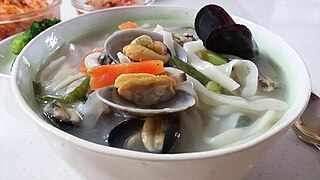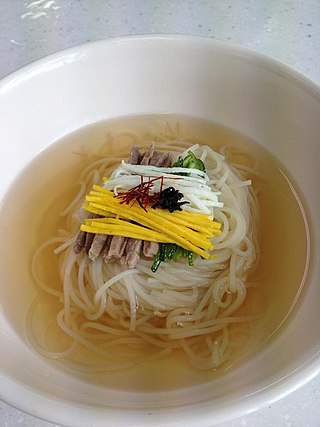
Buckwheat or common buckwheat is a flowering plant in the knotweed family Polygonaceae cultivated for its grain-like seeds and as a cover crop. Buckwheat originated around the 6th millennium BCE in the region of what is now Yunnan Province in southwestern China. The name "buckwheat" is used for several other species, such as Fagopyrum tataricum, a domesticated food plant raised in Asia.

A pancake is a flat cake, often thin and round, prepared from a starch-based batter that may contain eggs, milk and butter, and then cooked on a hot surface such as a griddle or frying pan. It is a type of batter bread. Archaeological evidence suggests that pancakes were probably eaten in prehistoric societies.

A crêpe or crepe is a dish made from unleavened batter or dough that is cooked on a frying pan or a griddle. Crêpes are usually one of two varieties: sweet crêpes or savoury galettes. They are often served with a wide variety of fillings such as cheese, fruit, vegetables, meats, and a variety of spreads. Crêpes can also be flambéed, such as in crêpes Suzette.

Naengmyeon or raengmyŏn is a noodle dish of northern Korean origin which consists of long and thin handmade noodles made from the flour and starch of various ingredients, including buckwheat, potatoes, sweet potatoes, arrowroot starch, and kudzu. Buckwheat predominates. Other varieties of naengmyeon are made from ingredients such as seaweed and green tea.

Mak-guksu (막국수) or buckwheat noodles is a Korean buckwheat noodle dish served in a chilled broth and sometimes with sugar, mustard, sesame oil or vinegar. It is a local specialty of the Gangwon province of South Korea, and its capital city, Chuncheon. Jaengban-guksu is a type of makguksu in which buckwheat noodles and various vegetables are mixed in a tray.

Noodle soup refers to a variety of soups with noodles and other ingredients served in a light broth. Noodle soup is a common dish across East Asia, Southeast Asia and the Himalayan states of South Asia. Various types of noodles are used, such as rice noodles, wheat noodles and egg noodles.

Memil-muk (메밀묵) or buckwheat jelly is a light gray-brown muk (jelly) made from buckwheat starch. It is commonly served as banchan as well as anju.

Kal-guksu is a Korean noodle dish consisting of handmade, knife-cut wheat flour noodles served in a large bowl with broth and other ingredients. It is traditionally considered a seasonal food, consumed most often in summer. Its name comes from the fact that the noodles are not extruded, pulled, or spun, but cut.

Korean noodles are noodles or noodle dishes in Korean cuisine, and are collectively referred to as guksu in native Korean or myeon in hanja character. Preparations with noodles are relatively simple and dates back to around 6000 BCE to 5000 BCE in Asia. In Korea, traditional noodle dishes are onmyeon, called guksu jangguk, naengmyeon, bibim guksu, kalguksu, kongguksu among others. In royal court, baekmyeon consisting of buckwheat noodles and pheasant broth, was regarded as the top quality noodle dish. Naengmyeon, with a cold soup mixed with dongchimi and beef brisk broth, was eaten in court during summer.

Sujebi, ttŭdŏ-guk, or hand-pulled dough soup, or Korean-style pasta soup, is a Korean traditional soup consisting of dough flakes roughly torn by hand, with various vegetables. The flavor and recipe resemble kalguksu, except that the latter is made with noodles rather than wheat flakes. It is commonly considered a dish to consume on rainy days, along with bindaetteok.

Janchi-guksu (Korean: 잔치국수) or banquet noodles is a Korean noodle dish consisting of wheat flour noodles in a light broth made from anchovy and sometimes also dasima (kelp). Beef broth may be substituted for the anchovy broth. It is served with a sauce made from sesame oil, ganjang and small amounts of chili pepper powder and scallions. Thinly sliced jidan, gim (laver) and zucchini are added on top of the dish as garnishes, though various other vegetables or kimchi can also be used. The word janchi means "feast" in Korean, in reference to the festive occasions on which the dish is prepared, such as for a wedding or sixtieth birthday celebration.

Memil-buchimgae (메밀부침개) or buckwheat pancake is a variety of buchimgae, or Korean pancake. It is a crepe-like dish made of thin buckwheat batter and napa cabbage.

Jat-guksu is a Korean noodle dish consisting of wheat flour or buckwheat noodles in a bowl of cold broth made from ground pine nuts. It is a local specialty of Gapyeong, Gyeonggi Province where a great deal of pine nuts are harvested in South Korea. The recipe is quite similar to another summer dish, kong-guksu, which is a noodle dish with a soy milk broth, but jat-guksu has a cleaner and more savory taste.
Korean regional cuisines are characterized by local specialties and distinctive styles within Korean cuisine. The divisions reflected historical boundaries of the provinces where these food and culinary traditions were preserved until modern times.

The Crêpe bretonne is a traditional dish in Lower Brittany, a region of France. It can be served plain, or with sweet or savoury fillings. The Crêpe bretonne can be made of wheat or buckwheat. The latter is less well-known and should not be confused with the buckwheat pancake typical of Upper Brittany, which has a different recipe.

Indonesian noodles are a significant aspect of Indonesian cuisine which is itself very diverse. Indonesian cuisine recognizes many types of noodles, with each region of the country often developing its own distinct recipes.





















